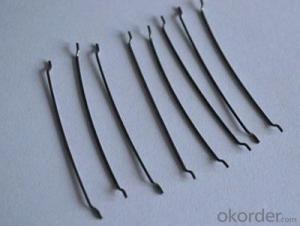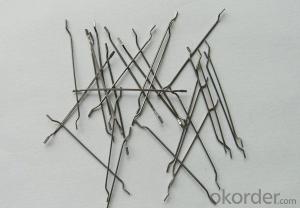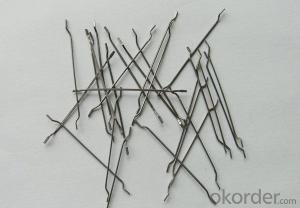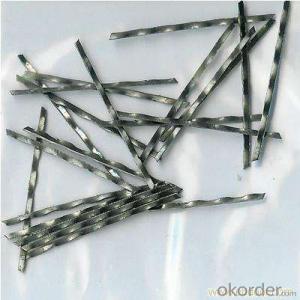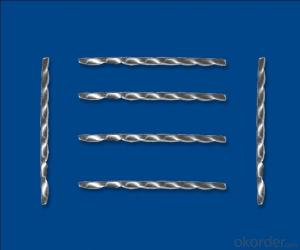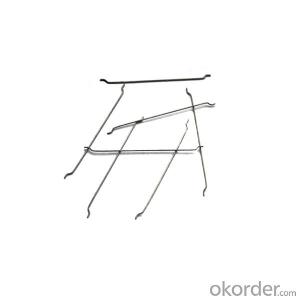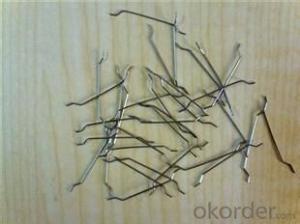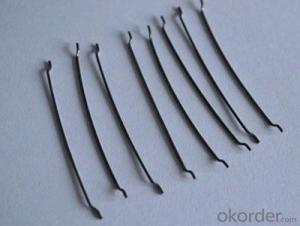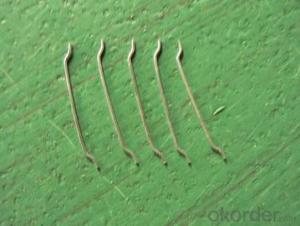Construction companies uae high quality steel fiber
- Loading Port:
- Tianjin
- Payment Terms:
- TT OR LC
- Min Order Qty:
- 1 m.t.
- Supply Capability:
- 600 m.t./month
OKorder Service Pledge
Quality Product, Order Online Tracking, Timely Delivery
OKorder Financial Service
Credit Rating, Credit Services, Credit Purchasing
You Might Also Like
Quick Details
Place of Origin: Tianjin, China (Mainland)
Model Number: 0.55
Material: Steel
Production Process: Cold drawn
Fiber Lengh: 35
Type: 1
Compressive Strength: >1200MPa
Aspect ratio: 63
Standard: ASTM A820M-11
Section Shape: Circular
Application: Concrete Reinforcement
Product Application: Industrial Floor
Packaging & Delivery
| Packaging Details: | 20 kg/Bag,50 bags/Pallet or 1,000kg/ Bulk Bag |
|---|---|
| Delivery Detail: | 1 Month |
Product Description
| Diameter | 0.55 mm (0.217 in) | ||
| Length | 35 mm (13.780 in) | ||
| Aspect Ratio | 63 | ||
| Tensile strength | 1200 MPa | ||
| Type | Cold drawn Steel Fiber | ||
| End | Hooked-end Steel Fiber | ||
| Glued/Loose | Glued Steel Fiber | ||
| Bending Angle | 45°(min.30°) | ||
| Usage & Performance | Floor:Trafficked areas and Industrial floors | ||
| Shotcrete :Slope stabilization and Final lining | |||
| Precast concrete:Pipe and Railway sleepers | |||
| Packing | Standard Export Pallet Packing | Bag Packing | 20 kg/Bag,50 bags/Pallet |
| Bulk Packing | 1,000kg/ Bulk Bag | ||
| Loading Quantity | 20’GP | 20-25 Tonne/Tonnes | |
| 40’GP | 25-27 Tonne/Tonnes | ||
| 40’HQ | 25-27 Tonne/Tonnes | ||
| MOQ | 1 kg for trial order | ||
| Supply Ability | 10,000 Tonne/Tonnes per Year | ||
| Payment Terms | T/T or L/C at sight | ||
| Delivery Time | Within 15 days after receiving deposit or original L/C at sight | ||
| Certification | ISO9001:2000, CE, | ||
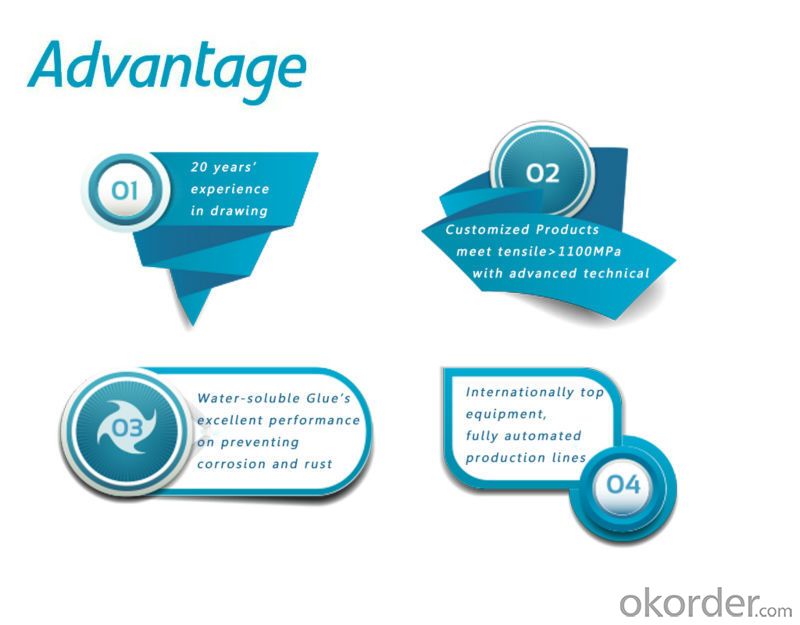
| Product | Diameter | Length mm/in | Aspect Ratio | Type | Packing |
| G-6030 | 0.5 mm (0.197 in) | 30 mm (11.811 in) | 60 | Glued | 20 kg/Bag, or 1,000kg/ Bulk Bag |
| G-6535 | 0.55 mm (0.217 in) | 35 mm (13.780 in) | 65 | Glued | 20 kg/Bag, or 1,000kg/ Bulk Bag |
| G-6035 | 0.6 mm (0.236 in) | 35 mm (13.780 in) | 60 | Glued | 20 kg/Bag, or 1,000kg/ Bulk Bag |
| G-8060 | 0.75 mm (0.295 in) | 60 mm (23.622 in) | 80 | Glued | 20 kg/Bag, 50 bags/Pallet |
| G-6060 | 0.9 mm (0.354 in) | 60 mm (23.622 in) | 60 | Glued | 20 kg/Bag, 50 bags/Pallet |
| G-6030 | 0.5 mm (0.197 in) | 30 mm (11.811 in) | 60 | Loose | 20 kg/Bag, or 1,000kg/ Bulk Bag |
| G-6535 | 0.55 mm (0.217 in) | 35 mm (13.780 in) | 65 | Loose | 20 kg/Bag, or 1,000kg/ Bulk Bag |
| G-6035 | 0.6 mm (0.236 in) | 35 mm (13.780 in) | 60 | Loose | 20 kg/Bag, or 1,000kg/ Bulk Bag |
| G-8060 | 0.75 mm (0.295 in) | 60 mm (23.622 in) | 80 | Loose | 20 kg/Bag, 50 bags/Pallet |
| G-6060 | 0.9 mm (0.354 in) | 60 mm (23.622 in) | 60 | Loose | 20 kg/Bag, 50 bags/Pallet |
- Q:How does the addition of melt extract stainless steel fiber affect the rheology of concrete?
- The addition of melt extract stainless steel fiber significantly affects the rheology of concrete by improving its overall performance and durability. One of the main effects of incorporating stainless steel fibers is the enhancement of concrete's tensile and flexural strength. The fibers act as reinforcement within the concrete matrix, effectively bridging cracks and increasing its resistance to cracking and fatigue. This results in a more ductile and robust material that can withstand higher loads and stresses without failure. Moreover, the addition of stainless steel fibers also improves the rheological properties of concrete. These fibers, being extremely fine and flexible, enhance the workability of the mix by reducing the viscosity and improving the flowability. This makes the concrete easier to pump, place, and compact, ultimately leading to better consolidation and higher quality finishes. Additionally, the presence of stainless steel fibers in concrete can modify its setting and hardening characteristics. The fibers act as nucleation sites for hydration products, accelerating the cement hydration process and promoting early strength development. This can be particularly beneficial in construction projects where fast setting times are required or in cold weather conditions where concrete may be prone to freezing. Furthermore, the stainless steel fibers also contribute to the overall durability of concrete. They provide a physical barrier against corrosion by reinforcing the concrete and preventing the ingress of moisture and aggressive chemicals, thus increasing the lifespan of the structure. This is especially crucial in harsh environments or in structures exposed to chemical attacks, such as wastewater treatment plants or marine structures. In conclusion, the addition of melt extract stainless steel fibers brings numerous benefits to the rheology of concrete. It improves its strength, workability, and durability, making it a reliable and high-performance construction material.
- Q:Steel fiber prices? (recent price)
- The main varieties of steel fiber are steel plate shearing type, steel wire cutting type and Steel Ingot Milling type. At present, shear steel fiber is the main application of steel fiber reinforced concrete in china.
- Q:How does melt extract stainless steel fiber contribute to the crack width control of concrete?
- The control of crack width in concrete is significantly influenced by the use of melt extract stainless steel fiber. This particular type of fiber is created through the process of melting stainless steel and rapidly extracting it, resulting in the formation of a material that is both strong and flexible. When incorporated into concrete mixes, these fibers enhance the material's tensile strength and flexibility, thus aiding in the control of crack width. As the concrete cures, it undergoes shrinkage due to the evaporation of water. This shrinkage can lead to the development of cracks, which have the potential to compromise the structural integrity of the concrete. However, by adding melt extract stainless steel fibers to the concrete mix, these fibers act as reinforcement, effectively bridging any cracks that may form. The high tensile strength exhibited by stainless steel fibers enables them to withstand the forces that cause cracks to widen. In instances where cracks do occur, the fibers distribute stress and prevent the cracks from expanding, thereby controlling the width of the cracks. This prevents the cracks from enlarging and potentially resulting in structural failure. Additionally, the ductility of stainless steel fibers allows them to deform without fracturing. This means that the fibers can absorb energy and accommodate movements within the concrete, thus reducing the likelihood of cracks widening. The combination of high strength and ductility offered by melt extract stainless steel fibers makes them an efficient solution for the control of crack width in concrete. To summarize, melt extract stainless steel fibers play a crucial role in controlling crack width in concrete by reinforcing the material, distributing stress, and preventing cracks from widening. Their excellent tensile strength and flexibility make them an ideal choice for enhancing the overall durability and lifespan of concrete structures.
- Q:What is the effect of melt extract stainless steel fiber on the alkali-silica reaction in concrete?
- Melt extract stainless steel fiber has a generally positive effect on the alkali-silica reaction in concrete. The alkali-silica reaction is a chemical reaction that occurs between the alkalis in cement and specific types of reactive silica found in concrete aggregates. This reaction can lead to significant expansion, cracking, and deterioration of the concrete over time. Nevertheless, the inclusion of melt extract stainless steel fibers in the concrete mix can serve as reinforcement and aid in mitigating the effects of the alkali-silica reaction. These stainless steel fibers offer additional structural support to the concrete, reducing the likelihood of cracking and enhancing the overall durability of the material. The stainless steel fibers also assist in controlling the expansion caused by the alkali-silica reaction by acting as a physical barrier that limits the movement of reactive silica particles. This barrier is effective in preventing crack formation and minimizing the damage caused by the reaction. Furthermore, the stainless steel fibers improve the mechanical properties of the concrete, including tensile strength, flexural strength, and impact resistance. This enhancement further enhances the concrete's performance in various applications, particularly in high-stress environments or structures where durability is of utmost importance. In conclusion, incorporating melt extract stainless steel fiber into concrete can effectively reduce the adverse effects of the alkali-silica reaction, resulting in improved long-term performance and durability of the concrete.
- Q:How does melt extract stainless steel fiber impact the workability of concrete?
- Melt extract stainless steel fiber has a significant impact on the workability of concrete. When added to concrete mixtures, these fibers enhance the overall workability and cohesiveness of the concrete mix, making it easier to handle and shape. One of the key benefits of using melt extract stainless steel fiber is its ability to improve the plasticity of the concrete. The fibers act as a reinforcement, distributing the load across the concrete mixture and reducing the risk of cracking and shrinkage. This results in a more workable and malleable concrete mix, allowing for better construction and finishing. Additionally, the addition of stainless steel fibers also enhances the overall strength and durability of the concrete. The fibers act as a reinforcement, providing additional tensile strength and preventing the formation of cracks. This not only improves the workability of the concrete but also increases its resistance to impact, vibrations, and other external forces. Moreover, melt extract stainless steel fibers improve the cohesion and cohesiveness of the concrete mix. These fibers create a three-dimensional network within the concrete, helping to hold the mixture together and reducing segregation and bleeding. This results in a more uniform and homogeneous concrete mix, making it easier to pour, spread, and finish. Overall, the addition of melt extract stainless steel fiber positively impacts the workability of concrete by improving its plasticity, strength, and cohesion. It enhances the overall handling and shaping characteristics of the concrete mix, resulting in better construction quality and improved durability.
- Q:What is the effect of melt extract stainless steel fiber on the flexural toughness of concrete?
- The flexural toughness of concrete is significantly influenced by the incorporation of melt extract stainless steel fiber. Known for their high tensile strength and ductility, stainless steel fibers play a crucial role in enhancing the flexural toughness of concrete. By adding stainless steel fibers to concrete, the material gains reinforcement and increased strength. These fibers are evenly dispersed throughout the concrete matrix, creating a three-dimensional network that effectively resists cracks and distributes the applied load more efficiently. Additionally, the melt extract stainless steel fibers contribute to the post-cracking behavior of concrete. When subjected to a load, these fibers act as bridges across any cracks that may form, effectively transferring stress and preventing further propagation of cracks. This bridge-like effect enhances the ductility and energy absorption capacity of concrete, thereby improving its flexural toughness. Numerous studies have demonstrated that the inclusion of melt extract stainless steel fibers can significantly enhance the flexural toughness of concrete, resulting in improved resistance against bending and impact forces. This is particularly advantageous in structural applications where concrete is exposed to dynamic loads or where enhanced durability and crack resistance are desired. In summary, the inclusion of melt extract stainless steel fiber in concrete positively impacts its flexural toughness through reinforcement, improved post-cracking behavior, and increased resistance to bending and impact forces.
- Q:Can melt extract stainless steel fiber be used in lightweight aggregate concrete wall panels?
- Yes, melt extract stainless steel fiber can be used in lightweight aggregate concrete wall panels. Stainless steel fibers are commonly used as reinforcement in concrete to improve its strength, durability, and resistance to cracking. The lightweight nature of the aggregate in the concrete panels makes them suitable for various applications, including wall panels, where the addition of stainless steel fibers can further enhance their mechanical properties.
- Q:Are there any guidelines or standards for using melt extract stainless steel fiber in construction?
- Yes, there are guidelines and standards for using melt extract stainless steel fiber in construction. The main standard that governs the use of stainless steel fiber in construction is ASTM A820. This standard provides guidelines for the classification, chemical composition, and mechanical properties of stainless steel fibers used in concrete reinforcement. According to ASTM A820, stainless steel fibers must meet specific requirements in terms of diameter, length, and tensile strength. The standard also specifies the minimum fiber content that should be added to concrete to achieve the desired reinforcement effect. In addition to ASTM A820, there are also other guidelines and standards that provide recommendations for the use of stainless steel fiber in specific applications. For example, the American Concrete Institute (ACI) provides guidelines on the use of stainless steel fiber reinforcement in shotcrete and precast concrete elements. It is important to note that while these guidelines and standards provide useful recommendations, they are not mandatory requirements. The specific requirements for using melt extract stainless steel fiber in construction may vary depending on the project specifications and local building codes. Therefore, it is always recommended to consult with design professionals and local authorities to ensure compliance with the appropriate guidelines and standards.
- Q:Can melt extract stainless steel fiber be used in bridge deck applications?
- Yes, melt extract stainless steel fiber can be used in bridge deck applications.
- Q:How does melt extract stainless steel fiber affect the cracking behavior of concrete?
- The cracking behavior of concrete is significantly impacted by melt extract stainless steel fiber. These fibers, produced by melting stainless steel and extracting it into varying lengths of fibers, are commonly used to reinforce concrete structures. Using melt extract stainless steel fiber has several benefits in enhancing the crack resistance of concrete. When added to the concrete mix, these fibers act as reinforcement, providing extra strength and preventing crack propagation. This is especially important for concrete structures that experience heavy loads or dynamic forces, as they are more prone to cracking. The presence of stainless steel fibers in concrete improves its tensile strength, which is usually lower than its compressive strength. Consequently, the concrete becomes more resistant to cracking as the fibers help distribute stress and prevent crack formation and propagation. This improved crack resistance is particularly advantageous in applications where concrete undergoes shrinkage, thermal expansion, or external loading, as it helps maintain the structure's integrity and durability. Furthermore, melt extract stainless steel fibers also improve the behavior of concrete after cracking. In conventional concrete, once a crack forms, it tends to spread rapidly, compromising structural integrity and reducing load-bearing capacity. However, with the addition of stainless steel fibers, these cracks are effectively bridged and restrained, reducing their width and preventing further propagation. This post-cracking behavior is crucial in maintaining the concrete's structural performance and serviceability under different loading conditions. In summary, melt extract stainless steel fiber has a significant impact on the cracking behavior of concrete by enhancing its crack resistance, tensile strength, and post-cracking behavior. By reinforcing the concrete matrix, these fibers prevent crack formation and propagation, improving the durability and structural integrity of concrete structures.
1. Manufacturer Overview |
|
|---|---|
| Location | |
| Year Established | |
| Annual Output Value | |
| Main Markets | |
| Company Certifications | |
2. Manufacturer Certificates |
|
|---|---|
| a) Certification Name | |
| Range | |
| Reference | |
| Validity Period | |
3. Manufacturer Capability |
|
|---|---|
| a)Trade Capacity | |
| Nearest Port | |
| Export Percentage | |
| No.of Employees in Trade Department | |
| Language Spoken: | |
| b)Factory Information | |
| Factory Size: | |
| No. of Production Lines | |
| Contract Manufacturing | |
| Product Price Range | |
Send your message to us
Construction companies uae high quality steel fiber
- Loading Port:
- Tianjin
- Payment Terms:
- TT OR LC
- Min Order Qty:
- 1 m.t.
- Supply Capability:
- 600 m.t./month
OKorder Service Pledge
Quality Product, Order Online Tracking, Timely Delivery
OKorder Financial Service
Credit Rating, Credit Services, Credit Purchasing
Similar products
New products
Hot products
Hot Searches
Related keywords





